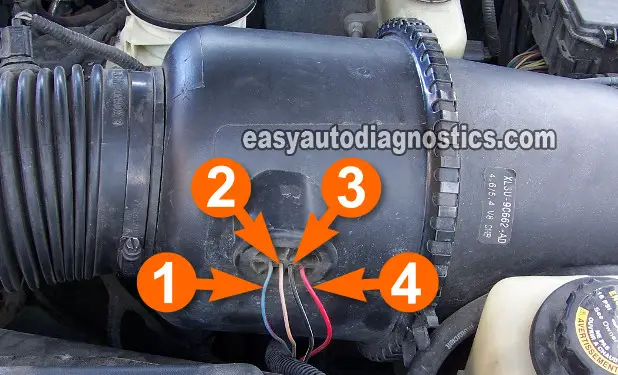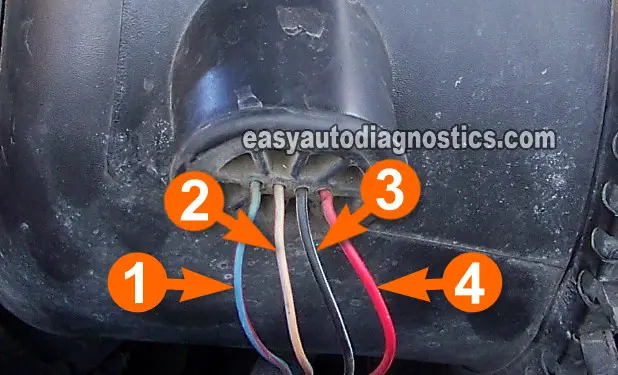
Testing the MAF (Mass Air Flow) sensor on your Ford truck or SUV or full size van is a very simple and easy affair. This article will walk you through the whole process without removing the MAF sensor from the engine. As you may already know, the MAF sensor is inside the round air filter canister assembly and this article will teach you how to test it.
The MAF sensor test/diagnostic can be accomplished in four easy steps using a multimeter. You don't even need a scan tool! Below you'll find important pre-test info that'll speed up the diagnostic process.
If you're looking for the article on how to test the Ford MAF sensor that's not inside the air filter canister assembly, go here: How To Test Ford MAF Sensors Using A Multimeter.
OK, one last thing before we jump into the test, if you're diagnosing a 4.6L or 5.4L pick up or SUV, let me just make you aware where you can find a complete list of 4.6L and 5.4L 'How To Test' articles that are located in this Web Site and at troubleshootmyvehicle.com and this list is found here: Ford 4.6L, 5.4L Index Of Articles.
Contents of this tutorial:
- Common Symptoms Of A Bad Ford MAF Sensor.
- Is My Ford MAF Sensor Just Dirty?
- Air Leaks Wreaking Havoc On MAF Sensor Control.
- Circuit Descriptions Of The Ford MAF Sensor's Connector.
- MAF Sensor Test Basics.
- TEST 1: Testing The MAF Signal.
- TEST 2: Testing The Power (12 V) Circuit.
- TEST 3: Testing The Chassis Ground Circuit.
- TEST 4: Testing The 2nd Ground Circuit.
![]() You can find this tutorial in Spanish here: Cómo Probar El MAF Ford (4.2L, 4.6L, 5.4L) (at: autotecnico-online.com).
You can find this tutorial in Spanish here: Cómo Probar El MAF Ford (4.2L, 4.6L, 5.4L) (at: autotecnico-online.com).
Common Symptoms Of A Bad Ford MAF Sensor
This list covers the majority of symptoms I've seen on these types of Ford mass air flow sensors:
- MAF Codes that light up the check engine light (CEL) on your instrument cluster.
- P0102: Mass Air Flow (MAF) Circuit Low Input.
- P0103: Mass Air Flow (MAF) Circuit High Input.
- MAF sensor malfunction that DOES NOT light up the check engine light (CEL).
- Lean and/or Rich code(s).
- Fuel Trim code(s).
- A tremendous lack of power upon acceleration.
- Black smoke coming from the tail-pipe.
- Bad gas mileage.
- Vehicle may idle rough and stall.
Is My Ford MAF Sensor Just Dirty?

MAF sensors have a tremendous tendency to get dirty and cause several headaches that may include: bad gas mileage, higher emissions, and/or lack of power. For the most part, when one is dirty, the truck, or van or SUV seems to drive OK, but not with the same peppiness as before. So how do I diagnose a dirty/contaminated Ford MAF sensor? Well:
- I'll take a quick look before I start my diagnostic and see if the two hot-wires (that make up the MAF sensor) are dirty. By dirty I mean 'contaminated' (to use an industry standard term). To see an example of this: Dirty MAF Sensor Example.
- Or, I'll test it first following the guidelines set in this article, to see if it's producing a MAF signal.
- If it is producing a signal, but the signal's response is too slow to changes in throttle position, then I know to look into cleaning it.
Why does it get dirty/contaminated? Well, it's usually due to an air filter not performing its job or the round plastic canister assembly, that holds the air filter, is broken or not sealing correctly. The Ford MAF sensors are some of the easiest MAF sensor to clean. To see/read the step by step instructions on how to clean this type of Ford MAF sensor in the round air filter canister, click here: Cleaning The Ford Canister Type MAF Sensor.

Air Leaks Wreaking Havoc On MAF Sensor Control
The second most common problem I have encountered on most Fords (Mercurys and Lincolns) over the years is air leaks between the MAF sensor and the throttle body. It is crucial, yes very critical that you first check that there are no air leaks between these two. Air entering after the mass air flow sensor into the engine will negatively impact fuel injection. And will skew the results of your tests which could result in the replacement of a good MAF (and in the process throwing money away).
How do you check for air leaks? With your eyes and hands. That's right, no special tools required. Just eyeball and physically shake/move the rubber air ducts that connect the MAF sensor to the throttle body to see if it's loose or disconnected.
Circuit Descriptions Of The Ford MAF Sensor's Connector

Whether you're driving a Ford, Mercury or Lincoln full size pick up (F150-F350), SUV, or full size van (E150-E350) the circuits descriptions of the wires coming out of the round air filter canister are the same. You'll notice that the photos (in the image photo above) have the MAF connectors numbered 1 thru' 4. I'll be using these numbers for the circuit descriptions. Here's the description of each circuit below:
- Number 1:
- MAF Signal.
- Number 2:
- Ground that the ECM provides.
- Number 3:
- Ground.
- Number 4:
- 12 Volts.
To test these circuits you'll need to use a tool to pierce the wire to be tested. I recommend using a wire-piercing probe since it'll be the most effective and easiest way of getting to the signal. If you need to see what this tool looks like, click here: Wire-Piercing Probe. Independent of the method you use, be careful not to damage the wire(s). Take all safety precautions.
Another important thing to note is that the color of the wires (coming out of your Ford, Lincoln or Mercury pick up or SUV or van) does not matter. In other words, the circuit description/job of the wire is the same regardless of Make/Model and color of the wire.
IMPORTANT: All of the tests are ON CAR TESTS, do not remove the mass air flow sensor from the vehicle or from its plumbing.
MAF Sensor Test Basics
OK, you're gonna' start by checking the basics. These are 12 Volts and battery Ground to the mass air flow sensor. After that, we'll test the actual performance of the MAF sensor as the engine is running. Use a digital multimeter for all tests where a multimeter is called for.
The MAF sensor produces an analog voltage signal. This MAF signal's DC voltage is directly related to amount of air the engine is breathing. Therefore, if the engine is breathing in more air at 2,500 RPM that at an idle of 900 RPM the voltage output will be greater at 2,500 RPM than at idle.
Now, when testing this voltage signal, the important thing to know is not an actual Volts number at a specific RPM, but to look for crazy and extreme fluctuations in the voltage signal that do not correspond to the actual air intake (RPM) of the engine or no signal at all. For example: If at Idle the voltage reading starts to spike up and down without you accelerating the engine or if there's no signal at all.
In the TEST 4 section of this article, I'll show how you'll use a base voltage reading at idle from the MAF sensor that will help you to confirm that the MAF sensor is bad or not.
TEST 1: Testing The MAF Signal

To get our MAF sensor diagnostic underway, we'll check the MAF signal coming out of the sensor and going to the PCM.
Start the engine and let it reach it's normal operating temperature. You'll be using the voltage reading you will obtain at idle as a base to diagnose the MAF sensor.
IMPORTANT: The MAF sensor on your Ford (Mercury or Lincoln) must be connected to its connector to perform this test. You'll need to use a back probe on the connector or a wire piercing probe on the signal wire. You can see an example of this tool and where to buy it here: Wire-Piercing Probe.
- 1
Turn the key in the OFF position.
- 2
Probe the wire labeled with the number 1 with the red multimeter test lead and a suitable tool.
- 3
Put the multimeter in Volts DC mode.
- 4
Connect the black multimeter test lead to the battery (-) negative terminal.
- 5
Start the already warmed up engine and let it run.
- 6
Note the Volts reading on your multimeter at idle (should be about 0.9 to 1 Volt DC).
This reading may be stable (with only small fluctuations) or unstable with very extreme fluctuations. No matter what the instability in the reading, this will be your base reading. - 7
Accelerate the engine (by manually opening the throttle plate) as you watch the multimeter's voltage readings. The voltage value should increase as you accelerate the engine.
At about 1500 RPM you'll see about 1.4 Volts DC.
At around 2500 RPM the multimeter should register around 1.8 Volts DC.
The actual voltage reading on your multimeter may/will vary slightly. - 8
When you release the throttle and the engine returns to idle, the voltage reading should decrease and hover around the reading that your multimeter registered in step 6 (about 0.9 to 1 Volt DC).
- 9
Accelerate/decelerate the engine as often as you need to verify that the voltage numbers on the multimeter increase/decrease every single time.
Let's take a look at what your test results mean:
CASE 1: The signal voltage increased/decreased as you accelerated/decelerated the engine. This test result lets you know that the MAF sensor is working OK.
If the mass air flow (MAF) sensor was bad, the output voltage number would stay stuck at one value regardless of how much you rev up or rev down the engine.
CASE 2: The signal voltage stayed stuck in one value as you accelerated/decelerated the engine. Recheck all of your connections and retest.
If still the multimeter does not show the voltage signal increasing/decreasing, your next step is to make sure it's getting power. Go to: TEST 2: Testing The Power (12 V) Circuit.
